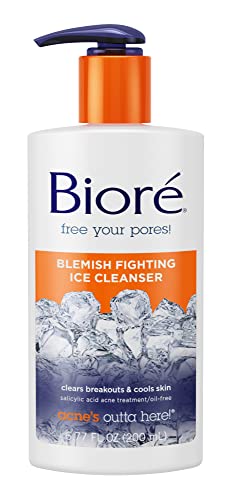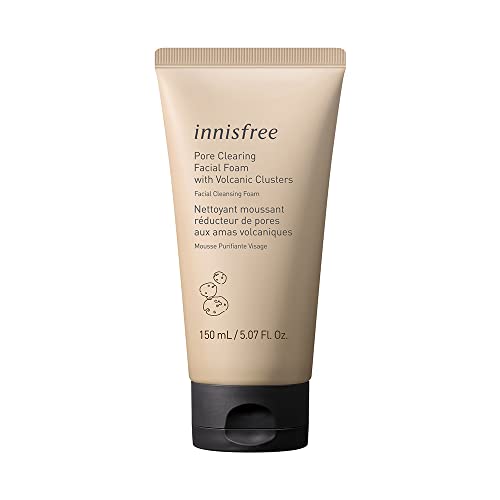
How to incorporate purifying facial foam into my skincare routine?
Are you looking for a way to improve your skincare routine and achieve a deep cleanse? Look no further – this step-by-step guide will teach you how to incorporate purifying facial foam into your daily routine. By following these simple steps, you can achieve a refreshed and revitalized complexion. So, let’s get started!
Top-selling face cleanser for a fresh complexion



Gather your supplies
Before you begin, gather all the supplies you will need. Start by grabbing the purifying facial foam cleanser, a clean towel, and a bowl of warm water. Having these items ready will ensure a smooth and hassle-free cleansing process.



Wet your face
- Wet your face with warm water by turning on the faucet and adjusting the temperature to a comfortably warm level.
- Use your hands to splash the warm water onto your face, making sure to cover your entire face and neck.
- Gently pat your face with a towel to remove excess water, leaving your skin damp and ready for the next step in your skincare routine.
Dispense the cleanser
To dispense the purifying facial foam cleanser, first, take a small amount and place it on your palm. It is important to use only a pea-sized amount as a little goes a long way. For example, imagine squeezing out the cleanser until you see a small mound on your palm, similar in size to a pea. This will ensure that you have just the right amount to effectively cleanse your face without wasting any product.



Create a lather
Rub your hands together vigorously to create a rich, foamy lather with the cleanser. This action helps to activate the ingredients and ensures a thorough cleanse of your skin. To create a lather, follow these steps:
- Wet your hands with warm water.
- Dispense a small amount of cleanser onto your palm.
- Rub your hands together in a circular motion, working the cleanser into a lather.
- Continue rubbing your hands together for about 20 seconds, ensuring all areas are covered.
- Pay special attention to the areas prone to oiliness or dirt buildup, such as the forehead, nose, and chin.
- Once a lather has formed, apply it to your face using gentle, upward circular motions.
- Be sure to cover your entire face, including the jawline and hairline.
- Massage the lather into your skin for about a minute, allowing the cleanser to work its magic.
- Rinse your face thoroughly with lukewarm water, making sure to remove all traces of the cleanser.
- Pat your skin dry with a clean towel, avoiding harsh rubbing.
By creating a lather and following these steps, you will effectively activate the ingredients of the cleanser and achieve a deep cleanse for your skin.
Apply to your face
- Gently massage the lather: Take a small amount of the face wash onto your fingertips. Start by gently massaging the lather onto your forehead using circular motions. Gradually move your fingers down to your nose, cheeks, and chin, ensuring that the lather covers your entire face.
- Use circular motions: As you massage the lather onto your face, use circular motions to help distribute the product evenly and stimulate blood circulation. Remember to be gentle and avoid tugging or pulling on your skin.
- Cover your entire face: Make sure the lather is applied to every part of your face, including hard-to-reach areas like the sides of your nose and jawline. Pay extra attention to areas prone to excess oil or dryness.
- Rinse thoroughly: Once you have massaged the lather onto your face, rinse it off thoroughly with lukewarm water. Make sure no traces of the face wash remain on your skin.
Following these steps will help ensure that the face wash is effectively applied to your face, helping to remove dirt, oil, and impurities while leaving your skin feeling refreshed and clean.

Avoid the eye area
- Be cautious: Take care to avoid the delicate eye area while applying the cleanser.
- Use separate products: Remember that the skin around the eyes is more sensitive and requires a separate eye makeup remover.
Rinse thoroughly
- Massage the cleanser into your skin using gentle circular motions.
- Once you have thoroughly massaged the cleanser into your skin, rinse your face with warm water.
- Make sure to rinse your face thoroughly, ensuring that all traces of the cleanser are removed from your skin.
- Use your hands or a soft cloth to gently pat your skin dry.
By following these steps, you will effectively clean your face and ensure that no residual cleanser is left behind.
Pat dry
- After rinsing your face, take a clean towel and gently pat it dry.
- Avoid rubbing your skin to prevent any irritation.
- Use light pressure and dab your face until it is completely dry.
- Make sure to use a clean towel each time to avoid transferring any bacteria or dirt onto your skin.
Follow with moisturizer
Apply a moisturizer to your face and neck immediately after cleansing. Gently massage the moisturizer into your skin using upward motions to promote absorption. Make sure to choose a moisturizer that matches your skin type, such as oil-free for oily skin or a thicker cream for dry skin. Remember to apply the moisturizer in the morning and evening for optimal hydration.
Repeat daily
- Start by wetting your face with warm water.
- Squeeze a small amount of purifying facial foam into your palm.
- Gently massage the foam onto your face using circular motions for about 1-2 minutes.
- Rinse off the foam thoroughly with lukewarm water.
- Pat your face dry with a clean towel.
- Follow up with your regular skincare routine, such as applying toner, serum, and moisturizer.
- Repeat this process daily, preferably in the morning and evening, to effectively cleanse and purify your skin.
Final Thoughts
In conclusion, adding purifying facial foam to your skincare routine is a simple and effective way to achieve clean and refreshed skin. By following the steps mentioned in this blog post, you can easily incorporate this product into your daily regimen. Say goodbye to dirt and impurities and hello to a healthier complexion!
Necessary Supplies






Skincare Hacks
How I Achieve a Double Cleansing Routine for Acne-Prone Skin
Steps for using Purifying Facial Foam
- Wet your face with lukewarm water
- Take a small amount of the purifying facial foam and apply it to your face
- Gently massage the foam into your skin using circular motions for about 1-2 minutes
- Rinse your face thoroughly with lukewarm water, making sure to remove all the foam
- Pat your face dry with a clean towel
- Follow up with your regular skincare routine, such as toner, moisturizer, and sunscreen
Answers to your frequently asked questions about Purifying Facial Foam
How does purifying facial foam differ from regular facial cleansers?
Purifying facial foam and regular facial cleansers differ in their composition and the way they cleanse the skin. Purifying facial foam typically contains ingredients like foaming agents and surfactants that create a rich lather when mixed with water. This lather helps to deeply cleanse the skin by removing dirt, oil, makeup, and impurities from the surface.
On the other hand, regular facial cleansers can come in various forms such as creams, gels, or liquids. They are generally milder and may not produce as much foam as purifying facial foam. Regular cleansers focus on removing surface-level dirt and grime, while still providing a gentle cleanse.
Another difference lies in the intended purpose of the products. Purifying facial foam is often formulated to address specific skin concerns such as excess oil, acne, or clogged pores. It may contain additional ingredients like salicylic acid or tea tree oil that help to target these issues. Regular cleansers, on the other hand, are more suitable for everyday use and maintenance of normal or combination skin, without specifically targeting particular skin concerns.
Ultimately, the choice between purifying facial foam and regular facial cleansers depends on individual skin type, concerns, and personal preference. It is important to consider one’s skin needs and consult with a dermatologist if necessary to determine the most suitable product for optimal skincare.
Can purifying facial foam help to control excess oil on the skin?
Yes, purifying facial foam can help to control excess oil on the skin. Facial foams specifically designed for purifying purposes often contain ingredients such as salicylic acid, tea tree oil, or activated charcoal. These ingredients have properties that can effectively remove excess oil from the skin and help to unclog pores. By using a purifying facial foam regularly, it can help to reduce the production of sebum, which is the oily substance produced by the skin’s sebaceous glands. This can result in a decrease in oiliness and shine on the skin, helping to control excess oil. However, it’s important to note that individual results may vary, and it’s also crucial to choose a facial foam suitable for your skin type to avoid any potential irritation or dryness.
What is purifying facial foam?
Purifying facial foam is a type of facial cleanser that is specifically formulated to remove impurities, dirt, oil, and makeup from the skin’s surface. It typically comes in a foam or gel form and is designed to deeply cleanse and purify the skin. The foam contains ingredients that help to unclog pores, control excess oil production, and remove dead skin cells, leaving the skin feeling refreshed and rejuvenated. Purifying facial foam is often used as a part of a daily skincare routine to maintain clean and healthy skin.
Are there any additional steps or products that should be used in conjunction with purifying facial foam?
Yes, there are additional steps or products that can be used in conjunction with purifying facial foam to enhance its effectiveness and provide a complete skincare routine. Some recommended steps and products include:
- Pre-cleansing: Before using the purifying facial foam, it is beneficial to remove makeup, dirt, and excess oils from the face using a gentle makeup remover or cleansing oil. This helps ensure a thorough cleanse and prevents clogged pores.
- Toner: After cleansing with facial foam, using a toner helps balance the skin’s pH level, tighten pores, and remove any remaining impurities. It also prepares the skin for better absorption of subsequent products.
- Exfoliation: Regular exfoliation using a mild scrub or chemical exfoliant can help remove dead skin cells, unclog pores, and improve the texture and brightness of the skin. However, it is important not to over-exfoliate, as it can irritate the skin.
- Serum: Applying a serum after cleansing can provide targeted treatment for specific skin concerns. Serums are highly concentrated with active ingredients that can address issues like acne, hyperpigmentation, dryness, or aging. Choose a serum based on your specific skincare needs.
- Moisturizer: After cleansing and applying a serum, it is crucial to moisturize the skin to keep it hydrated and nourished. Look for a moisturizer suitable for your skin type, whether it is oily, dry, or combination. Moisturizers help maintain the skin’s moisture barrier and prevent water loss.
- Sunscreen: Regardless of the weather or skin type, applying sunscreen is an essential step in any skincare routine. Sunscreen protects the skin from harmful UV rays, preventing sunburn, premature aging, and the risk of skin cancer.

Hey, I’m Ava Wilson—a skincare enthusiast and a certified esthetician. I’m dedicated to sharing my knowledge and empowering others to achieve healthy, glowing skin through simple, effective routines and natural remedies. Join me on this exciting skincare journey, and let’s unlock your skin’s potential for a confident, beautiful you.





